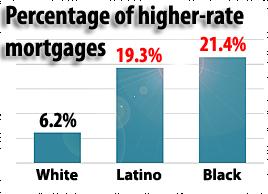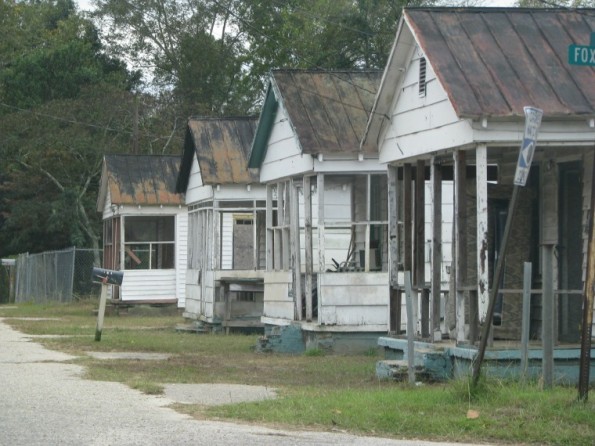Archive
Negative equity is disproportionately concentrated in the Chicago region’s communities of color, Woodstock Institute report shows
 Tom Feltner | Vice President
Tom Feltner | Vice President
Woodstock Institute
Homeowners with mortgages in African American communities more than twice as likely to be underwater as homeowners in white communities
CHICAGO–Negative equity is disproportionately concentrated in the Chicago region’s African American, Latino, and majority minority neighborhoods, a new report from Woodstock Institute found. The report also found that borrowers in communities of color have much less equity on average than do borrowers in predominantly white communities.
View the full report here: http://bit.ly/strugglingtostayafloat
Join us for a telephone briefing Tuesday March 27 at 10am CT: http://stayingafloat.eventbrite.com/
The report, “Struggling to Stay Afloat: Negative Equity in Communities of Color in the Chicago Six County Region,” used data from a major provider of mortgage and home value data to examine patterns of underwater homes in communities of various racial and ethnic compositions in the Chicago six county region in 2011. It found that:
- Nearly one in four residential properties in the Chicago six county region is underwater, with just under $25 billion of negative equity. The average underwater property has 31.8 percent more outstanding mortgage debt than the property is worth.
- Borrowers in communities of color are much more likely to be underwater than are borrowers in white communities.
- Borrowers in communities of color are more than twice as likely as are borrowers in white communities to have little to no equity in their homes. In highly African American communities in the Chicago six county region, 40.5 percent of borrowers are underwater, while another 5.4 percent are nearly underwater. Similarly, 40.3 percent of properties are underwater in predominantly Latino communities and 5.3 percent are nearly underwater. In contrast, only 16.7 percent of properties in predominantly white communities are underwater, with another 4.4 percent nearly underwater.
- Almost three times as many properties in communities of color are severely underwater compared to properties in white communities. In predominantly African American communities, 30.1 percent of properties have loan-to-value (LTV) ratios—a comparison of outstanding mortgage debt to home value—exceeding 110 percent, while that figure is 30 percent in predominantly Latino communities. In contrast, just 10.1 percent of the properties in predominantly white communities have LTVs exceeding 110 percent.
- Borrowers in communities of color have much less equity in their homes than do borrowers in white communities, resulting in a significant wealth gap.
- Only about one-third of homeowners in communities of color have significant equity in their homes. In predominantly African American communities, 34.5 percent of borrowers have more than 25 percent equity in their homes, while 33.1 percent of borrowers in Latino communities have more than 25 percent equity in their homes. Fifty-five percent of borrowers in predominantly white communities have more than 25 percent equity.
- Borrowers in communities of color have much higher average loan-to-value ratios than do borrowers in predominantly white communities. The average LTV ratio is 92.1 in predominantly African American communities and 87.4 in Latino communities, compared with an average LTV ratio of 67.7 in predominantly white communities.
Negative equity contributes to community decline by potentially leading to increased foreclosure activity, threatening the success of foreclosure prevention programs, and draining neighborhood wealth. In addition, the destruction of assets caused by negative home equity may disproportionately threaten the economic security of people of color because home equity is a larger proportion of their net worth than it is for white people.
View the full report here: http://bit.ly/strugglingtostayafloat
The report concluded with a number of policy recommendations to reduce the negative impacts of concentrated negative equity, including:
- Servicers should use principal reduction as a foreclosure prevention tool more broadly.
- The Federal Housing Finance Authority should permit loans backed by Fannie Mae and Freddie Mac to be eligible for principal reductions.
- Servicers should streamline processes for short sales.
—
Tom Feltner | Vice President
Woodstock Institute
29 E Madison Suite 1710 | Chicago, Illinois 60602
T 312/368-0310 x2028 | F 312/368-0316 | M 312/927-0391
www.woodstockinst.org | tfeltner@woodstockinst.org | @tfeltner
Related articles
- A good credit score did not protect Latino and black borrowers (scoppcanton.wordpress.com)
- Negative Equity Increasing Around US; but Not Oro Valley (finehomesdigest.wordpress.com)
- Housing Still Drowning in Underwater Mortgages (blogs.wsj.com)
States with highest foreclosure rates shift
December, 2011 unemployment: 9.9% (6th highest)
Home price change (2006Q3-2011Q3): -49% (3rd largest decline)
Processing period: 135 days
2. New Jersey—
2011 foreclosure rate: 6.4%
December, 2011 unemployment: 9% (13th highest)
Home price change (2006Q3-2011Q3): -22.6% (14th largest decline)
Processing period: 270 days
3. Illinois—
2011 foreclosure rate: 5.4%
December, 2011 unemployment: 9.8% (7th highest)
Home price change (2006Q3-2011Q3): -29% (7th largest decline)
Processing period: 300 days
4. Nevada—
2011 foreclosure rate: 5.3%
December, 2011 unemployment: 12.6% (the highest)
Home price change (2006Q3-2011Q3): -59.3% (the largest decline)
Processing period: 116 days
5. New York—
2011 foreclosure rate: 4.6%
December, 2011 unemployment: 8% (23rd highest)
Home price change (2006Q3-2011Q3): -13.6% (23rd largest decline)
Processing period: 445 days
Related articles
- Foreclosure activity edges higher in January (usatoday.com)
- Foreclosures and a Small Sign of Housing Recovery (247wallst.com)
- Foreclosures climbed in January (money.cnn.com)
- Chicago Foreclosure Activity in 2011 Indicates Hot Foreclosure Market in 2012 (prweb.com)
From Bad To Worse: Nevada Foreclosures Only Half Way Done
Timothy Pratt – Timothy Pratt writes on employment, economic and immigration issues out of Las Vegas, Nevada,
January 31, 2012
Nearly 1 in 7 Nevadans who bought homes between 2004 and 2008 are at least 60 days behind in their mortgage payments or entering foreclosure, according to a new report. That’s almost the same amount that have already been foreclosed on, meaning the state may only be halfway through its housing crisis.
What’s more, only Florida has a higher share of mortgages that are “seriously delinquent” or in foreclosure, meaning Nevada’s unfortunate status as ground zero for the issue may last a while.
Due to the complex relationship between underwater and foreclosed homes and unemployment, this issue goes beyond homeownership itself and is a drag on the overall economy.
The report, “Lost Ground, 2011,” was prepared by the Center for Responsible Lending. It includes state-by-state analyses of mortgages taken on during the height of the nation’s real estate boom and not only looks at their current status, but breaks them down by race, ethnicity and income.
It concludes that “the nation is not even halfway through the foreclosure crisis,” considering that 2.7 million homes have been foreclosed on, but 4 million more are inches from the same end.
In that sense, Nevada is like the rest of the nation; the difference is in the share of mortgages.
According to the report’s interactive map, the top five states in their share of mortgages at risk of foreclosure, are Florida, with 17.4%; Nevada with 13.4%; New York with 9.8%; New Jersey with 9.7%; and Mississippi with 9.6%.
The map allows you to see where the problem might be heading, which isn’t necessarily where it’s been in all cases, as with Michigan, which has been near the top until now, but may fall into the middle in the near future. Nevada has led the nation in foreclosures for some time, so that may remain the case.
Other findings include:
– middle- to upper middle class homeowners are more affected by the housing crisis in boom areas like the Las Vegas Valley; and
– Hispanics and blacks, particularly the former, are more likely to fall behind in payments and face foreclosure.
The center also makes a series of policy recommendations aimed at regulating the mortgage industry and protecting consumers. It seems these ideas may be lost in the months leading up to the elections, as debt and jobs fight for the spotlight and members of Congress fight each other.
Timothy Pratt writes from Las Vegas, Nevada. This story was originally published in his blog, Back to Work. If you would like to contribute as a citizen journalist to The Huffington Post‘s coverage of American political life, please contact us at www.offthebus.org.
Related articles
- Nevada court enforces rule that lenders must have all foreclosure papers (alialawgroupforeclosurenews.com)
- Nevada Foreclosure Filings Drop After Anti-Fraud Law Takes Effect (huffingtonpost.com)
- California, Nevada form alliance to crack down on foreclosure fraud (cnn.com)
Low Mortgage Rates — Finally Having Impact on Housing Market?
 CIN Alert for January 24, 2012
CIN Alert for January 24, 2012
Vicky and Joe had always dreamed of buying a nice neat home in a Northern city suburb. That dream came true in 1972 when they purchased a Cape Cod style three bedroom home for $45,000 with a 30-year fixed-rate mortgage of 7.5%.
Joe remembers telling Vicky at the time that they would never see rates that low again, and over most of the next 40 years he was right.
However, something quite unusual has happened during the past several years: mortgage rates have plummeted to new record low levels, most recently 3.88 %. Of course, Joe and Vicky, now retired, don’t need the low rates anymore, but for many others – including their kids and grandkids — those rates seem very inviting.
Inviting they may be, but the low rates have not thus far been able to trigger a strong stimulation of the US housing market as (sad to say) relatively few people qualified for the lower rates. High unemployment and small wage gains have made it harder for many people to qualify. Other would-be borrowers didn’t want to sink money into a home that they fear could lose value over the next few years.
However, new statistics just released would seem to indicate that things are beginning to change. Perhaps there is good news coming over the horizon.
“Existing home sales rose for the third consecutive month in December, according to data released Friday by the National Association of Realtors, which touts the upswing as a sign of recovery in the national housing market.
“Sales of existing homes rose to a seasonally adjusted rate of 4.42 million during the final month of the year, marking a 5% increase over the downwardly revised 4.39 million homes sold in November and a 4 percent increase over the 4.25 million homes sold in October.
“The number of homes sold in December 2011 also marked a 3.6 percent increase over the 4.45 million homes sold during the same month one year ago. “The pattern of home sales in recent months demonstrates a market in recovery,” NAR chief economist Lawrence Yun said in a statement. “Record low mortgage interest rates, job growth and bargain home prices are giving more consumers the confidence they need to enter the market.” (Source: The Washington Post)
Builders are hopeful that the low rates will boost sales even more as the year progresses. In fact, low mortgage rates were cited as a key reason the National Association of Home Builders survey of builder sentiment rose in December to its highest level in more than a year.
Mortgage rates are one of the major issues your CIN editors monitor and report on regularly in our Housing Section, which is designed to provide information to prospective homebuyers, their counselors and advisors, lenders, developers, and others focused on the critical issues surrounding housing.
These include aspects of arranging financing and other details of the purchasing process, such as obtaining a fair appraisal of the value of the intended home. We also present information on various bank mortgage lending programs and mortgage banking programs to help borrowers understand the process they are entering as they select a home for purchase. Here’s a sample of some articles recently included in CIN’s Housing Section:
One million homeowners may get mortgage writedowns: U.S.
(Source: Reuters) About one million American homeowners would get write downs in the size of their mortgages under a proposed deal with banks over shady foreclosure practices. The deal, which could be struck within weeks, would mark the largest cut in the mortgage load since the start of the credit crisis.
Do FHA Mortgage Borrowers Still Face Credit Score Layering?
(Source: Our Broker.com) More than a year has passed since HUD announced that it would investigate 22 lenders on possible ‘Layering’, the addition of requirements on top of FHA standards. The investigations are in response to 22 complaints the National Community Reinvestment Coalition (NCRC) filed with HUD alleging that the loan activities of the mortgage originators showed that their home lending practices deny FHA- insured loans to African-Americans and Latinos with credit scores as high as 640.
WSJ: Home Equity Squeeze Sparks Reverse Mortgage Revival
(Source: Reverse Mortgage Daily) The real-estate crunch left most home values with much to be desired, prompting a revival in reverse mortgages. Although the number of reverse mortgage endorsements has decreased compared to its peak a few years ago, lending has been picking up, with MetLife Bank’s 2011 reverse originations increasing by 171% compared to the previous year.
Confidence Among U.S. Homebuilders Climbs to Highest Since 2007
(Source: Bloomberg) Confidence among U.S. homebuilders rose in January to the highest level in more than four years as sales and buyer traffic improved. The National Association of Home Builders/Wells Fargo sentiment gauge increased to 25 this month, exceeding the median forecast of economists surveyed by Bloomberg News and reaching the highest level since June 2007.
Feds investigating possible fraud at GE’s former subprime unit
(Source: i watch news) Federal authorities are investigating possible fraud at General Electric Co.’s former subprime mortgage arm amid increased public pressure to hold Wall Street accountable for its role in the financial crisis.
Mortgage, foreclosure issues top AG’s complaint list for the first time
(Source: Boston.com) Complaints about mortgage, loan modification and foreclosure issues soared in 2011 and were the biggest source of problems for consumers who asked the Massachusetts State Attorney General’s office for help.
COMMENTARY:
Why Falling Home Ownership Is a Good Thing
(Source: The Motley Fool) Commentator Dan Caplinger opines that falling levels of home ownership may not be such a bad thing, since for many, owning a home never made financial sense and avoiding the burden of having so much debt on one’s biggest asset can make financial life a lot easier.
Related articles
A good credit score did not protect Latino and black borrowers
 Economic Policy Institute
Economic Policy Institute
Research and Ideas for Shared Prosperity
EPI News: Read about EPI’s latest research, publications, upcoming events, and related stories
January 20, 2012
In recent years, Latino and African American consumers with good credit scores of 660 and higher have too often ended up with high-interest-rate mortgages—mortgages that are supposed to go to risky borrowers. This week’s Economic Snapshot illustrates that from 2004 to 2008, only 6.2 percent of white borrowers with credit scores of 660 and above ended up with higher-rate mortgages. Latinos and blacks with good credit scores were at least three times as likely to end up with higher-rate mortgages.
“Discriminatory housing practices are one reason why our country needs a strong Consumer Financial Protection Bureau,” said Algernon Austin, director of EPI’s Race, Ethnicity, and the Economy program.
Austin’s research on the recession’s overall impact on the economic status of African Americans continues to be a key resource for reporters. His work most recently appeared in Forbes and The Grio.
Focusing on Dr. Martin Luther King Jr.’s pursuit of economic justice for all Americans, Forbes contributor Joel Kotkin stressed the significant amount of work that remains to be done, particularly with respect to the African American community. “While African-Americans make up 12% of the nation’s population, they account for 21% of the nation’s unemployed. Unemployment for black men stands at a staggeringly high 19.1%, and the Economic Policy Institute estimates that overall black unemployment will remain well above 10% till at least 2014,” wrote Kotkin.
The Grio columnist Monique W. Morris highlighted Austin’s research showing that African American under-and unemployment statistics dwarf their white counterparts both in good economic times and downturns. Morris wrote, “Research by Algernon Austin at the Economic Policy Institute has demonstrated the consistently high rates of under- and unemployment among African-Americans as evidence of a ‘permanent recession.’ This is true, he argues, when the economy is strong. So, when the rest of the nation is experiencing a recession, what are African-Americans experiencing? That’s right, a depression.”
Related articles
- A jobs-centered approach to African American community development : The crisis of African American unemployment requires federal intervention (scoppcanton.wordpress.com)
- Discrimination settlement holds subprime lenders accountable (thegrio.com)
- Class Discussion and In-Class Introductory Quiz: Your Credit Score (artkeown.com)
Justice Department Advocates Boosting Research, Funding For Foreclosure Mediation Programs
The Huffington Post
Jillian Berman
First Posted: 1/10/12 05:47 PM ET
Updated: 1/10/12 05:47 PM ET
Suddenly all the government agencies are giving their two cents on foreclosure.
Foreclosure mediation, the process whereby homeowners negotiate with lenders so they need not lose their homes, is worthy of a boost in research and possibly federal funding, according to a new report from a Justice Department panel.
As millions of homes in the foreclosure pipeline weigh on home prices and the housing recovery, government officials have considered a variety of avenues to aid struggling homeowners, mostly to limited success. Federal Reserve Chairman Ben Bernanke advocated that lenders “aggressively” pursue loan modifications and other alternatives to foreclosure in a paper released last week.
The Home Affordable Modification Program, which Obama announced in February 2009, had helped roughly 750,000 homeowners as of November, though it was touted as a plan to aid 3 to 4 million.
Though foreclosure mediation is available in a number of states, the Justice Department report comes as some are ending their versions of the program due to concerns over its efficacy. A Florida Supreme Court Justice ended the state’s mandatory foreclosure mediation program last year, after a task force of judges recommend that it be terminated due to its low success rate, The Miami Herald reports. In Maryland, just 56 borrowers got a modification through the program in the space of a year and only 1,000 borrowers had applied, according to Mother Jones.
A 2009 study from the National Consumer Law Center found that foreclosure mediation programs can often be ineffective because they produce agreements that lack any mechanism for enforcement. Though the Justice Department report doesn’t include recommendations for giving the agreements teeth, it does offer recommendations that could give foreclosure mediation programs a bit more clout.
The panel suggested creating federal guidelines for the programs, which currently vary from state-to-state, also recommending the federal government match funding for state programs that meet those guidelines. In addition, the report urges that federally-backed loans go through mediation before foreclosure can take place.
In some states the programs have already been a success even without a federal boost. More than 10 percent of Nevada homeowners in danger of default had taken advantage of the state’s mediation program within the first six months of its inception. And Michigan Governor Rick Snyder extended the state’s foreclosure mediation program through this year, according to Housingwire.
Related articles
- Justice Endorses Foreclosure Mediation (pubcit.typepad.com)
- Big Bank’s Foreclosure Fine Laughably Small (huffingtonpost.com)
Making Those Mortgage Payments May Pay Off – After All
 CIN Alert for November 1, 2011
CIN Alert for November 1, 2011
The last 18 months have been rough for Dana. Sad to say, in the midst of the continuing Great Recession, she and her husband of three years have parted company. He’s not willing to help her at all, so she now has full responsibility for raising two toddlers and maintaining her job as a restaurant manager, while also paying the mortgage on their modest two-story home each month. There have been months when money has been so tight she’s had to ask her Mom to help out. Still, through all the adversity, Dana has managed to make her monthly mortgage payments on time. She’s never missed a payment, nor even been late.
Unfortunately, the value of her home has plunged from what it was when she purchased it in 2007, so she now finds herself in the same position as many other homeowners do today: upside down with a mortgage rate much higher than today’s going rates. Until now, there has been no way she could refinance or modify her mortgage loan to relieve some of the fiscal pressure she faces every month. However, there are signs that maybe — finally – there could be light at the end of the tunnel for Dana and millions of other Americans in the same boat underwater:
“The Obama Administration is launching yet another high-profile campaign to shore up the housing market — and with it, the economy — by making it easier for some struggling homeowners to refinance underwater mortgage loans at today’s ultra-low interest rates.
The federal government’s new rules will encourage borrowers to secure new loans no matter how much value their homes have lost during the nation’s housing crisis, with the hitch that they can’t have missed any mortgage payments for the last six months.
The plan could help 1 million to 2 million people get significantly lower monthly payments in hopes of stabilizing the real estate market. On top of that, it would boost the economy by putting about $2,500 more in a typical homeowner’s pocket each year, administration officials said. The plan amounts to a sweeping overhaul of the 2½-year-old Home Affordable Refinance Program, easing rules and reducing fees to allow many more homeowners potentially to take advantage of historically low mortgage rates.
The revisions include lifting a ceiling that barred participation by borrowers who owed more than 125% of the value of their homes, and using a controversial modeling method to replace costly appraisals that are among the fees that have kept some homeowners from refinancing. About 14.6 million mortgages nationwide were underwater at the end of the first quarter, about 29% of the nearly 51 million residential mortgages nationwide, according to Moody’s Analytics and Equifax.” (Source: Los Angeles Times)
Will these steps help? Stay tuned. Buying and maintaining a home can be a very emotional process for families. This is the largest purchase most individuals will make — and one with long-lasting effects. The home purchase process can also be confusing, and the terms of the loans offered are not always understandable for most of us (remember all the pages at closing!). It’s especially crucial in today’s economy that homeowners be aware of all the options available to them, and to avoid those deals that “sound too good to be true.” The results of the Obama Executive Orders will be seen in the weeks ahead.
Meantime, there are millions of homeowners today in desperate need of assistance with their housing issues. The CIN editors are watching many developments for you.
CIN’s Housing Section is a dependable reference tool for current and prospective homeowners. Information is updated on a daily basis. We offer details on various bank mortgage lending programs and mortgage banking programs to help borrowers understand the process they are entering as they select a home for purchase, or ways to maintain/refinance their home after purchase. It seems hardly a day goes by without another dramatic development. Consider these recent examples:
Mortgage refinancing to get easier under revised U.S. program
(Source: Los Angeles Times) New rules being implemented by the federal government will encourage borrowers to secure new loans no matter how much value their homes have lost during the nation’s housing crisis.
Obama looks to bypass Congress with help for homeowners, students
(Christian Science Monitor) President Obama is bypassing Congress and using executive powers to enact change. Strapped homeowners and indebted students are first in line under his relief plan.
SHRA to expand program to buy, rehab and resell foreclosed properties
(Source: Sacramento Press) The Sacramento Housing and Redevelopment Agency can now grant developers a first look at foreclosed properties for rehab and resale in Sacramento’s low- and moderate-income neighborhoods – before the properties are put on the open market. Through the new program developers can purchase vacant, foreclosed properties at discounted prices and then rehabilitate and resell those properties.
Cost of Fannie & Freddie bailouts trimmed
(Source: CNN Money) The cost to taxpayers for bailing out mortgage finance giants Fannie Mae and Freddie Mac won’t be quite as bad as previous estimates.
The FHA now estimates that the net cost of the bailouts through 2014 will be about $124 billion, down about 19% from an estimate of $154 billion a year ago.
Reverse Mortgages to be Scrutinized
(Source: Mortgage Loan.com) Older borrowers are getting a new resource to assist them with reverse mortgages and other financial matters, courtesy of the new Consumer Financial Protection Bureau (CFPB). The Office of Financial Protection for Older Americans is one of several entities being established under the new bureau, with the goal of promoting financial literacy among Americans age 62 and over, and protecting them from unfair and abusive practices regarding financial decisions.
Senate Adopts Measure to Increase Fannie, Freddie Loan Limits
(Source: Bloomberg) The U.S. Senate has adopted a measure that would raise the maximum size of a home loan backed by mortgage companies Fannie Mae, Freddie Mac and the Federal Housing Administration to $729,750. The measure was approved less than a month after the limit on so-called conforming loans was automatically reduced to $625,500.
Related articles
- The Pros & Cons of Reverse Mortgages (orangecountymortgage.co)
- National Mortgage Complaint Center Warns Homeowners About Mortgage Refinance Scams & Explains How Homeowners About To Refinance Can Save Money (prweb.com)
- Freddie Mac seeks $6 billion more in aid (bottomline.msnbc.msn.com)






